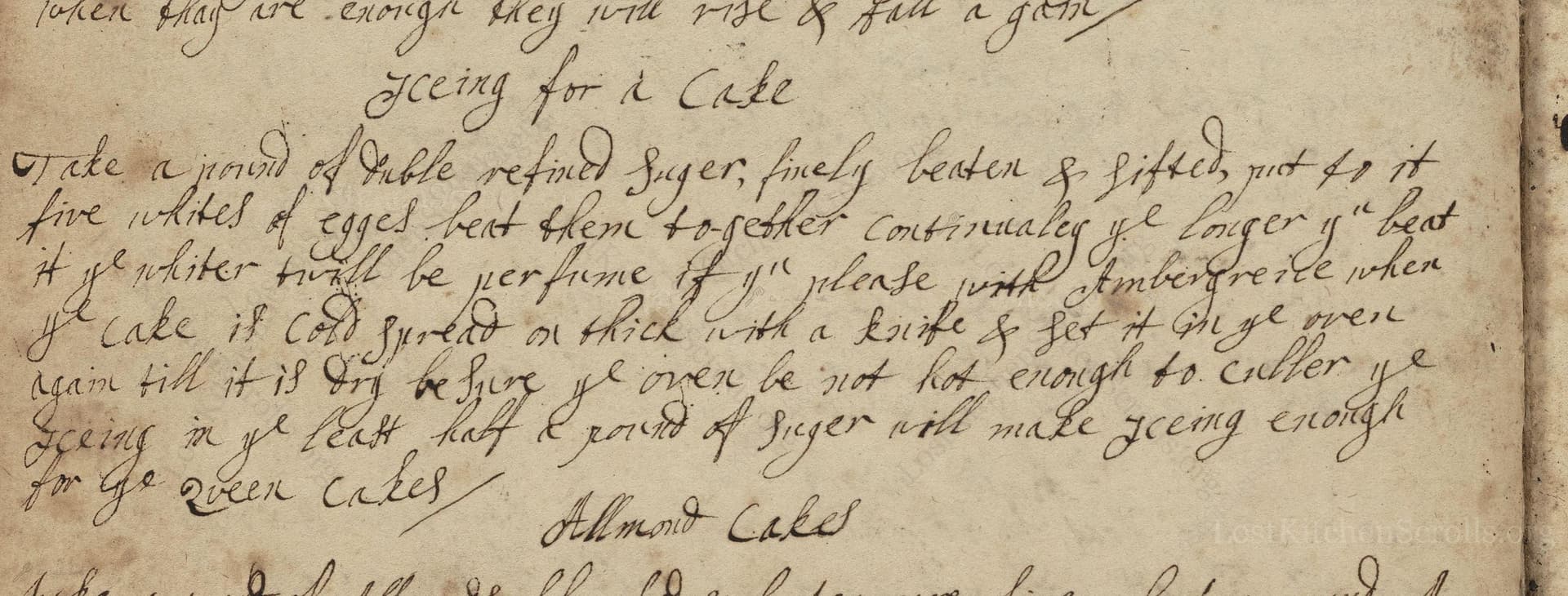Iceing For A Cake
From the treasured pages of Receipt book of Jane Staveley
Written by Jane Staveley

Iceing For A Cake
"Take a pound of double refined suger finely beaten & sifted, put to it five whites of egges beat them up together continualey ye longer you beat it ye whiter twill be perfume if you please with Amber greice when ye cake is cold spread on thicke with a knife & set it in ye oven again till it is dry be sure ye oven be not hot enough to culler ye Iceing in ye least half a pound of suger will make iceing enough for ye Queen cakes"
Note on the Original Text
The recipe is written in the fluid, inconsistent spelling typical of 17th-century English and in a conversational tone, assuming a knowledgeable reader familiar with basic techniques. Words like 'suger' (sugar), 'egges' (eggs), and 'ye' (the) reflect shifting standards in spelling and typography. Quantities are given by weight (pound, half a pound), and directions are minimal but direct, with a focus on physical signs like color and texture. The recipe assumes access to rare ingredients and offers flexibility by suggesting a perfume if you please.

Title
Receipt book of Jane Staveley (1693)
You can also click the book image above to peruse the original tome
Writer
Jane Staveley
Era
1693
Publisher
Unknown
Background
Step into the flavorful annals of the 17th century with Jane Staveley’s delightful culinary collection. Brimming with time-honored recipes and refined instructions, this book offers a sumptuous glimpse into the kitchens of yesteryear—where classic techniques met noble tastes and every dish was a celebration of ingenuity.
Kindly made available by
Folger Shakespeare Library
This recipe comes from Jane Staveley's handwritten collection dated 1693–1694, a delightful period in English culinary history when home cooks readied rich cakes and sweets for celebrations. Icing, as we know it today, was becoming fashionable—this was before the introduction of royal icing or fondant. Sugar, having become more accessible and affordable, was now a centerpiece of display and delight, and elaborate cakes often bore glossy, snowy icings to show off their maker's skill and status. Ambergris, a rare and costly ingredient from the intestines of sperm whales, was sometimes used as a perfume for icing or chocolate. Today, it is mostly replaced by floral waters or vanilla in home baking.

In the late 17th century, cooks would have used a large wooden or pewter bowl for beating the egg whites and a sturdy whisk made from birch twigs or wire. The sugar was pounded fine with a mortar and pestle and sifted through muslin or a hair sieve. The icing was spread over the cake with a simple table knife. Cakes were returned to the cooling bread oven, taking advantage of the gentle declining heat after baking was done—no modern thermostats, so cooks judged by feel and experience.
Prep Time
20 mins
Cook Time
1 hr
Servings
12
We've done our best to adapt this historical recipe for modern kitchens, but some details may still need refinement. We warmly welcome feedback from fellow cooks and culinary historians — your insights support the entire community!
Ingredients
- 1 lb (16 oz) powdered (icing) sugar, double refined if possible
- 5 egg whites
- A trace of ambergris (historical; substitute with rosewater or vanilla extract if desired)
- For smaller cakes, use 8 oz (1/2 lb) sugar and 2–3 egg whites
Instructions
- Start by finely grinding and sifting 1 pound (16 ounces) of powdered (icing) sugar.
- In a clean bowl, separate and beat 5 egg whites until frothy and slightly stiff.
- Gradually add the sifted sugar, beating vigorously until the mixture becomes glossy, smooth, and bright white—the longer you beat, the better the texture and color.
- If desired, perfume with a trace of ambergris (rare and expensive today; use a drop of rosewater or vanilla for a gentler flavor).
- When your cake is completely cool, generously spread the icing over the surface with a knife, creating a thick layer.
- Return the cake to a barely warm oven (around 140–175°F), just enough to dry out the icing thoroughly, but not so hot that it changes color.
- For smaller cakes (like Queen cakes), halve the ingredients for a lighter coating.
Estimated Calories
120 per serving
Cooking Estimates
Preparing the icing takes about 20 minutes, including sifting the sugar and beating the egg whites until stiff and glossy. Drying the icing in a low oven usually takes around 1 hour. Each serving has about 120 calories, based on dividing the icing for a standard cake into 12 portions.
As noted above, we have made our best effort to translate and adapt this historical recipe for modern kitchens, taking into account ingredients nowadays, cooking techniques, measurements, and so on. However, historical recipes often contain assumptions that require interpretation.
We'd love for anyone to help improve these adaptations. Community contributions are highly welcome. If you have suggestions, corrections, or cooking tips based on your experience with this recipe, please share them below.
Join the Discussion
Rate This Recipe
Dietary Preference
Main Ingredients

Den Bockfisch In Einer Fleisch Suppen Zu Kochen
This recipe hails from a German manuscript cookbook compiled in 1696, a time whe...

Die Grieß Nudlen Zumachen
This recipe comes from a rather mysterious manuscript cookbook, penned anonymous...

Ein Boudain
This recipe comes from an anonymous German-language manuscript cookbook from 169...

Ein Gesaltzen Citroni
This recipe, dating from 1696, comes from an extensive anonymous German cookbook...
Browse our complete collection of time-honored recipes



